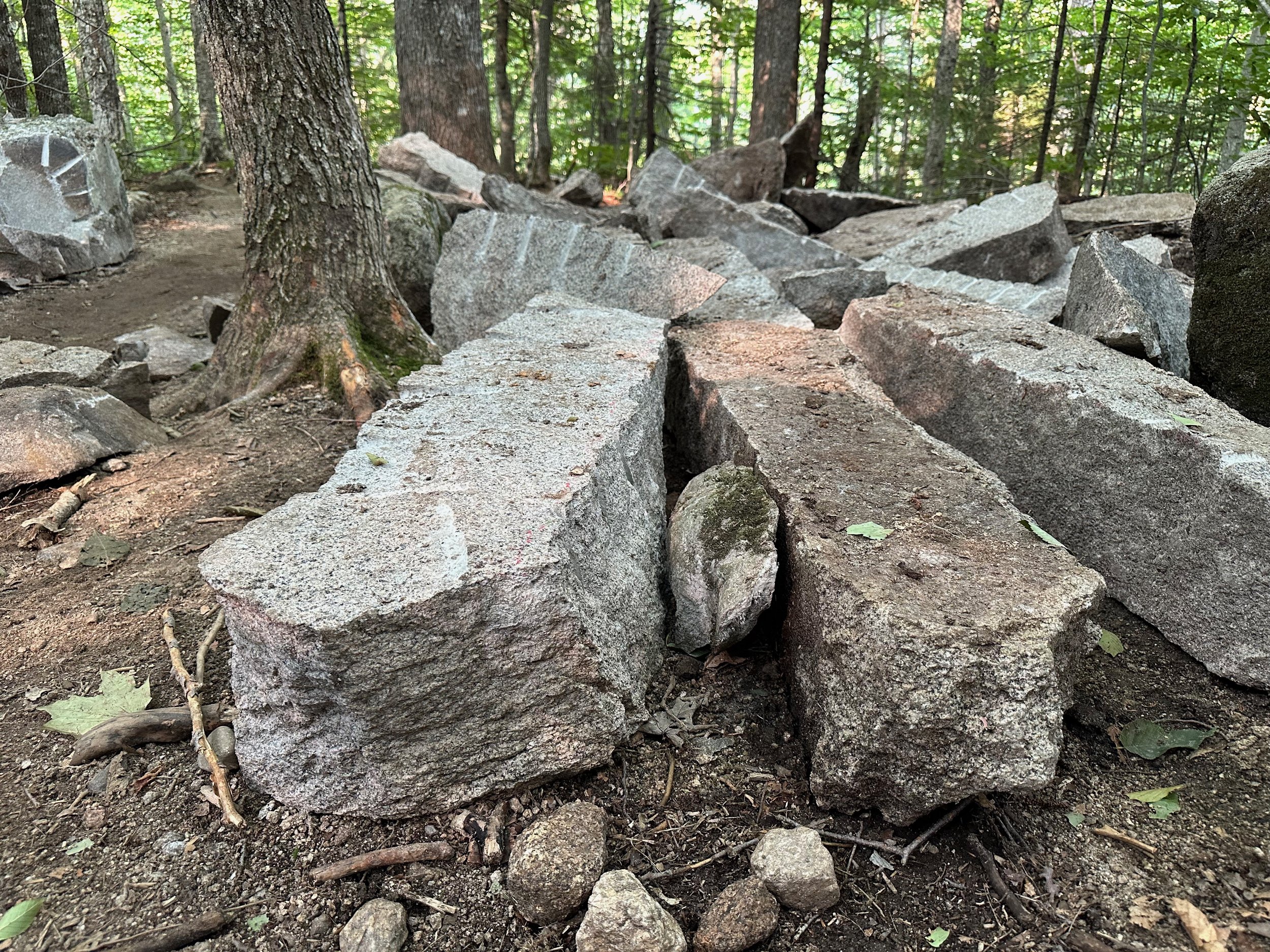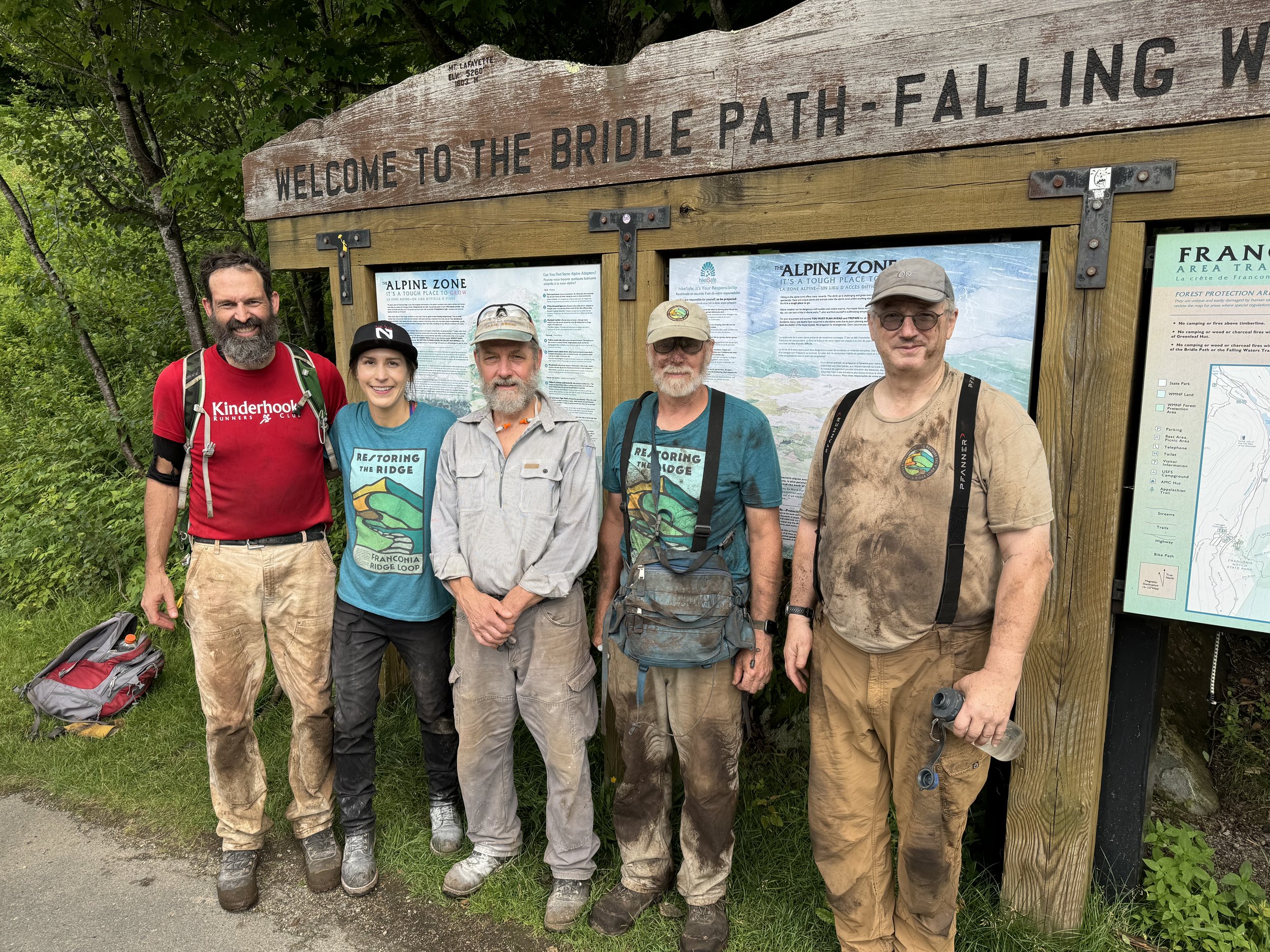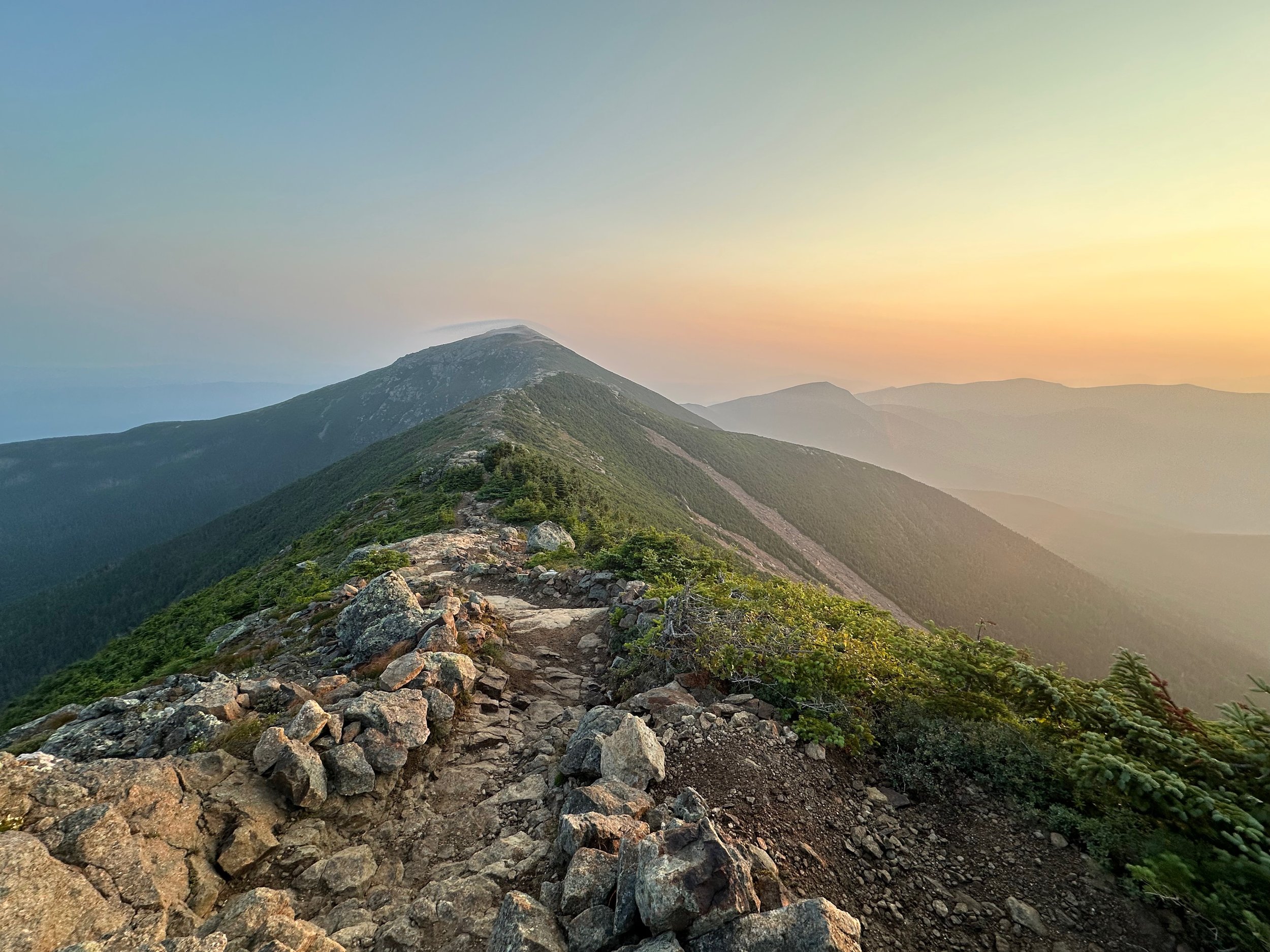The First 4,000 Feet of the New Old Bridle Path Are Open, Thanks to Team Effort
Will the Franconia Ridge restoration project shape the future of White Mountain trails?
On July 14, 2024, I decided to solo hike. I packed up my tent at the campground I was staying at fairly early—around 6:30 a.m.—to head to my favorite loop in the White Mountains, the Franconia Ridge Loop. I arrived to Falling Waters Trailhead around 7:30 a.m. to find that the parking lot was already full, as was the overflow lot across the street, so I decided to save the ridge for another day and continued down 93-South to hike the Osceolas as a backup.
Toward the end of the month, one of my friends invited me to hike, so I suggested that we do the ridge. It was a perfect day—we summited Little Haystack right before sunrise and enjoyed views of the colorful sky behind peaks in the distance. We walked across the iconic ridge and captured an endless amount of photos.
The Ridge
Standing on the summit of Mount Lafayette before descending Greenleaf Trail to Old Bridle Path. Photo by Paul Noel.
On the way down Old Bridle Path from the Greenleaf Hut, I noticed that the trail looked different—it was built from fresh rock as a staircase and felt easier on my feet than usual. My friends Paul and Nichole said that work had been done to restore Old Bridle Path. In fact, they had volunteered on the project with the World Trails Network (WTN) just recently. I knew then and there that I needed to learn more about the work on trail, known as the “Restore The Ridge” project, which involves efforts from federal, state, and non-profit conservation partners, as well as professional trail builders.
The Popularity of the Franconia Ridge Loop
Only In Your State writes that National Geographic named the Franconia Ridge Loop trail one of the best hikes in the world. Veteran and newbie hikers alike make their way to this 8.9-mile loop year round to tackle its three summits: Little Haystack, Mount Lincoln, and Mount Lafayette, two of which are on the official New Hampshire 4,000 footers list. On a clear day, the ridge offers breathtaking views of the Pemigewasset Wilderness, Franconia Notch, peaks in Vermont, and Mount Washington, as well as a sense of triumph as you walk past the rugged rock formations standing strong.
“You can have like 300 or 400 people on top of Little Haystack or Mount Lafayette [at a time],” says Robert White, project manager for the WTN on the Restore The Ridge Franconia Ridge Partnership. Every year, the Franconia Ridge Loop receives more than 40,000 hikers in total.
Franconia Notch History and Impact
The Franconia Notch has long been an area of both concern and pride in the state of New Hampshire. Originally, the notch was home to the Old Man of the Mountain, who fell in 2003, which has drawn in visitors for decades. With Interstate 93 running right through the notch, the area became easy to access for tourists. What’s more, the popularity of the Appalachian Trail, which includes the ridge, increased foot traffic in the area from all of the “thru-hikers” attempting to complete their 2,190-mile journey. Chris Thayer, Appalachian Mountain Club’s (AMC) Senior Director of External Affairs, says that AMC has heavily studied and maintained the ridge for decades following guidance from White Mountain National Forest land managers due to the level of use and visitation.
“I’ve seen quite a bit of change over the years, on the trail, as more and more people have been hiking,” says Nathaniel Scrimshaw, director of the WTN-Americas, who are a partner on the project.
In the 1970’s, the large hiking crowds, high number of cars, and increase in traffic were causing the environment and trails on the Franconia Ridge Loop to deteriorate—leading to vegetation loss, soil compaction, and severe erosion on the trails. In 1975, AMC lobbied to make the road a two-way parkway to decrease the number of cars going through it at a time. The following year, they also saw a major need to build a new trail across the alpine zone on the ridge. Rock steps and scree walls were built to create a three-foot-wide trail that was meant to define a walkable route for hikers and keep them off of the fragile alpine ecosystem. The human touch may have aided in defining the trail, but the greater human intervention was at the hands of vigorous protests led by the famous hiking couple and authors, Guy and Laura Waterman.
Restoration Project Plans
Ever since the ridge was worked on in the 1970’s, efforts have been made to educate the public on vegetation protection. As the popularity of the ridge continued to grow, the need for alpine stewardship did as well. Organizations such as the White Mountain National Forest (WMNF), AMC, WTN, and Scrimshaw’s “West End Trail Tenders” group each played a role in placing summit stewards and ridge runners on the ridge to guide, educate, and even rescue or help injured hikers. In fact, Falling Waters Trail has more accidents than the rest of New Hampshire trails combined.
The environmental health of the ridge was reaching a crisis point, In 2017, Scrimshaw and the WTN sponsored a program for state and federal agencies, which included the WMNF, New Hampshire State Parks, AMC, and the WTN. All of these organizations had become concerned with protecting the alpine zone on the ridge and keeping hikers safe on trail. Therefore, the “Franconia Ridge Working Group” was formed to begin the planning process and address these issues.
In 2022, the AMC wrote a congressional spending request to Senator Jeanne Shaheen for a five-year project to restore the ridge. The project was approved for almost 1.125 million dollars, and in the fall of 2022, AMC began restoration work on Old Bridle Path, which ascends to Greenleaf Hut and Mount Lafayette. In addition to the federal funds, AMC also contributed $300,000 to the project.
Learning that the funds only covered the federal portion of the land, White engaged in the project through the WTN and secured funding for work on the Old Bridle Path in the state park section. A private donor contributed $200,000 and the WTN’s work began in 2022. The success of the first year brought the donor family back with a multi-year financing plan for the Old Bridle Path and Falling Waters Trail that may reach $500,000 to rebuild and relocate the loop to be a long-term, sustainable trail.
Work by professional trail builder Peter Jensen, owner of Peter S. Jensen & Associates, LLC, who are the prime contractor for the WTN and leader of trail construction for the state park portion, and subcontractor, Trail Fixing Collective, LLC, will continue each year from May to October, complemented by volunteer work.
At the same time, AMC has staffed work in the national forest section of Old Bridle Path with a massive effort from AMC staff members, trail contractors, and conservation partners. Alex DeLucia, AMC’s Director of Trails & Recreational Management, says that each organization involved is working together to develop a standard set of specifications and best trail design and construction practices for the trail so the work will be enduring for the trails over the next century.
“That transition from state to federal—there’s that consistency in the structural work we’re installing, or trail realignments that we’re building,” he says.
Ready to Rebuild
Stones being used to restore the trail. Photo by Lily Hartman.
Rebuilding the Trail
Restoring the Ridge will preserve the woodland trails and alpine environment for future generations, according to White. The process involves contractors and volunteers working together to remove rock from the ground to construct trails. Originally, Old Bridle Path was built just a couple of feet wide, meaning it was designed for single tread. Therefore, when hikers pass by one another, especially on busy trails like the Franconia Ridge Loop, they’re more likely to walk on the side instead of on the steps. This leads to issues with trail widening and braiding, and vegetation loss.
White Mountain trails are also typically built as fall line trails, which is the line where water naturally flows. This causes foot traffic to compact and kill organic soil, making it erode away. The new trail is designed as a sidehill trail, which winds hikers up the mountain instead of directly, which is more sustainable long term.
“That means that we’re actually making the trail a little bit longer,” says Jensen. Building these trails involves fine stonework, subtle drainage, and trail grading—making the process a combination of art, science, construction, and environment.
Jensen’s team and the subcontractors work together to build safe and effective trails. They identify natural and large boulder outcroppings of stone in the woods, then use either the natural form of the rock or drill and split it to create materials needed for step construction. This summer, over 150 steps were quarried from the mountain and transported to the trail to be placed as steps. Stones are cut to create smooth step, while the natural-shaped stones are placed along the edges to support the slope of each step. Then, they bench cut the trail where it is earthen. A technique called “grade reversals” is used on the top step to shed stormwater much better than the original trail. These grade reversals have proven themselves effective in previous storms on the Franconia Ridge Loop.
Restore the Ridge Team
White, Scrimshaw, Aissa, and others on site for trail work. Courtesy photo.
Evelyn Aissa, an avid hiker of the White Mountains, discovered the ridge project last spring and wanted to get involved. She began doing trail work with the United States Forest Service (USFS) a couple of years ago and took one of AMC’s trail training programs, which opened up a whole new world for developing her technical skills in trail building and maintenance. Now, she is on the WTN advisory committee for the project and helps out for as many working days as possible each year.
“[The volunteers] are a humble, hardworking, really fun group of people,” says Aissa. Volunteer days are organized by AMC. In 2023, there were up to 120 volunteers involved in the 10 working days on Old Bridle Path. This year, the WTN ‘s work involved almost 200 volunteers as of October 2024.—saving the project budget for the trail contractors work. As an extension of the partnership, AMC supports WTN volunteers by providing organizational and safety services on project sights.
On a typical working day, volunteers are set up with tools and tasks based on their skill level and what they’re comfortable with doing. For example, some volunteers may clear drainages and do stone work while others get to actually build the steps and spit stones. Volunteers are split based on how many show up and what’s needed for the day. One of Aissa’s favorite trail crew experiences was clearing 1,600 feet on the new section of Old Bridle Path—two teams from opposite directions raced to a central “golden spike” in a single day .
“Since I started doing trail work, I don’t look at the trails the same.” says Aissa. “Now I really understand what it takes to build them, and that adds so much experience to the meaning of using them.”
AMC has put in significant work up the infamous “Agony ridge,” located on the Old Bridle Path, to Greenleaf Hut and Mount Lafayette. As of early September, the first 4,000 feet of the new relocation of Old Bridle Path in the state park has been completed and is open for use.
White and an AMC volunteer working together to move a stone. Photo by Philip J. Carcia.
Preserving the Loop For the Long Term
It will take several more years to complete the ridge project. The funds only cover work in the national forest on Old Bridle Path, meaning more will be needed for further restoration work. Building a wider trail to promote two-way traffic takes longer and more time and effort. With the ridge only being 40 to 50 feet wide, hikers have heavily trampled on vegetation when there’s congested two-way traffic. Sometimes, there are as many as 250 people an hour passing the alpine zone. To fix this, the Franconia Ridge Working Group is hoping to widen the ridge in the near future.
What’s more, sections of Falling Waters Trail near Cloudland Falls, where a majority of accidents occur, according to New Hampshire Fish and Game, will be relocated so this section becomes a sidehill trail that is more accessible to hikers who can manage the rocky ledges. It’s currently located on a steep and eroded section of the trail that is vulnerable to flooding, and therefore accidents. The plans to relocate this trail are currently pending approvals. Some fall line sections on this trail are eroded as deep as six inches into dangerous gullies, making their need for restoration crucial.
Jensen says that hikers passing by the trail crew on Old Bridle Path have made positive comments about the work being done and appreciate the trails becoming easier to walk on. The crew even says that the new gradual trail is easy on the knees. Although, Scrimshaw says that, “we’re not building [the trails] to make them easier to hike, we’re building them to protect the resource, the drainage, and the erosion.”
AMC volunteers moving stones for trail work. Photo by Philip J. Carcia.
To support the “Restore the Ridge” project, people can donate to organizations involved to support different sections of the trail, such as the WTN for the state park portion or AMC for work on federal land. The WTN will be looking for volunteers to sign up again next year. Volunteers each receive a Restoring the Ridge Graphic T-shirt—also available to purchase as a donation at the Cannon Mountain Aerial Tramway, Flume Gorge, and Lahouts.
The Future of Environmental Protection in the Whites
The work being done on Old Bridle Path could redefine what trails could look like in the front country in the White Mountains, according to Jensen. By building sidehill trails, maintenance needs can be reduced long term. For example, White says that Randolph Path, a gradual trail that ascends to Mount Jefferson, has no erosion, while Valley Way, a fall line trail that heads toward Mount Madison and Adams, has required thousands of hours and dollars to stay preserved. The question is, would turning Valley Way into a sidehill trail increase its sustainability? The results of the “Restore the Ridge” project may offer a solution.
While the wider, formal-cut steps of the Old Bridle Path are now needed on many other trails, people also admire the natural ruggedness of the White Mountains and believe that is what makes them special. With the amount of traffic the Franconia Ridge Loop receives each year, this new trail design was necessary, but the greater challenge of how to handle the eroded trails in the rest of the White Mountains still looms.
“There needs to be a more comprehensive rethinking of the White Mountain National Forest recreation and these problems of overuse and trail designation.” says Scrimshaw.
In addition to changing the way trails are built, there are many other strategies being considered to reduce the environmental impact on the Franconia Ridge Loop. One potential solution to the overuse issue is to implement a permit system or timed-entry passes, although this would increase concerns with administrative capacity. Another solution would be to stop the hiker shuttle system that takes hikers to popular trailheads in the area, such as Falling Waters Trail and Old Bridle Path. Since parking is banned on the side of the road in the area, the shuttle bus made it easy for people to still hike the ridge. This wouldn’t decrease the volume of hikers on the ridge, but it does encourage hikers to start the ridge from Greenleaf Trail instead of Old Bridle Path or Falling Waters Trail because it’s closer to shuttle parking.
“It flattened the curve of the wave of people going over the ridge,” says Scrimshaw.
Scrimshaw has one concern with improving Old Bridle Path—he believes that the new trail may put more pressure on the ridge since it will be easier to access. Overall, when it comes to protecting the fragile environment on the ridge, there is no perfect solution—the best thing we can do is help protect the ecosystem in the best way we know how, and that starts with building an appropriate trail.
“We’re not making more Franconia Ridges,” says Thayer. “The landscape is the landscape.”
Looking out at Mount Lafayette on the ridge, July 28, 2024, 6:05 a.m. Photo by Lily Hartman.









